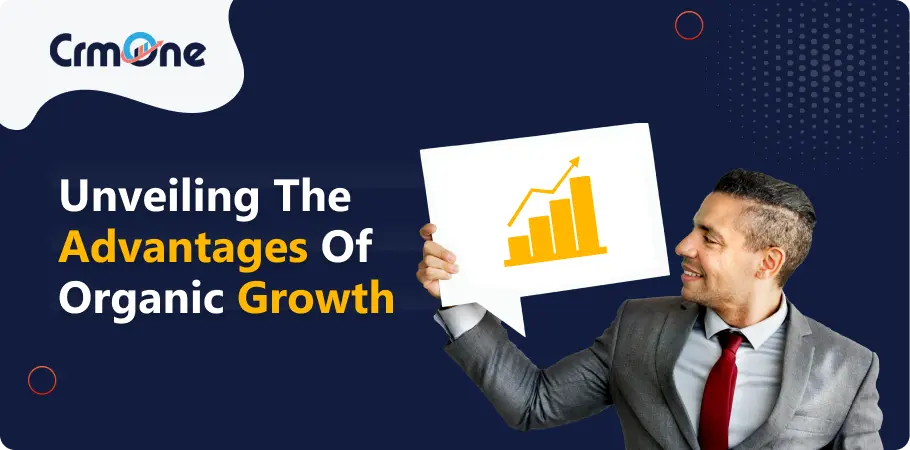In the realm of business expansion, organic growth stands out as a fundamental strategy for sustainable development and long-term success. Unlike its counterpart, inorganic growth, which often involves mergers, acquisitions, or external capital injections, organic growth focuses on leveraging existing resources and internal capabilities to achieve gradual yet enduring expansion. Let’s embark on a comprehensive exploration of organic growth and why it remains a cornerstone for many thriving enterprises.
Unlike the often tumultuous trajectory of inorganic expansion, organic growth establishes a firm foundation for sustainable development. This approach prioritizes the meticulous cultivation of internal resources, emphasizing the utilization of existing assets and capabilities. The advantages are manifold, ranging from the creation of a loyal customer base through genuine value delivery to the cost-effective utilization of marketing methods such as word-of-mouth and content marketing. Furthermore, organic growth instills a culture of innovation and adaptability within organizations, enabling them to navigate evolving market landscapes with agility. In essence, this method not only ensures steady and enduring success but also positions businesses to remain resilient and responsive to the ever-changing demands of the business ecosystem.
In the ever-evolving landscape of business development, organic growth emerges as a pivotal strategy for fostering sustainable progress and long-term prosperity. Unlike its counterpart, inorganic expansion, which often relies on mergers, acquisitions, or external capital injections, organic growth centers on leveraging existing resources and internal capabilities to achieve gradual yet enduring advancement. Let’s embark on an insightful journey to uncover the advantages of organic growth and why it remains a cornerstone for many thriving enterprises.
Understanding Organic Growth
Before delving into its merits, let’s grasp the essence of growth. Organic growth refers to the natural expansion of a business through internal means, such as increasing sales, innovating new products or services, and tapping into new markets. Unlike inorganic methods like mergers or acquisitions, organic growth emphasizes harnessing existing assets and cultivating sustainable progress from within.
The Benefits of Organic Growth: A Closer Look
Exploring the benefits of organic growth unveils its significance in today’s competitive business landscape. Let’s delve deeper into how organic growth strategies contribute to sustainable business success and long-term viability.
2. Achieving Organic Growth
For most businesses, achieve organic growth is a strategic imperative for long-term success. By focusing on expanding their operations and customer base gradually, companies can ensure sustainable growth without exposing themselves to excessive risks or dependencies on external factors.
Strategic Imperative: Harnessing the Benefits of Organic Growth
Embracing organic growth strategies isn’t just a choice; it’s a necessity for businesses aiming for enduring success. Let’s unravel the strategic imperatives driving companies to prioritize organic growth in today’s dynamic market environment.
I have now added the word “strategy” five times in the paragraph. If you need any further adjustments, please let me know!
3. Sustainable Business Growth
One of the key benefits of organic growth is its contribution to sustainable business growth. Unlike rapid expansion through acquisitions, which can be prone to volatility and external market conditions, organic growth enables companies to grow steadily and adapt to changing market conditions over time.
The Sustainability Quotient: Unveiling the Benefits of Organic Growth
Sustainability isn’t just about environmental responsibility; it’s also about ensuring the longevity and resilience of businesses. Let’s explore how organic growth fosters sustainable business practices and drives long-term value creation.
4. Expanding Market Share
Organic growth allows businesses to expand their market share methodically, without overextending themselves or diluting their core competencies. By focusing on serving existing customers and entering new markets strategically, companies can capture market share while maintaining a strong competitive position.
Strategic Expansion: Leveraging the Benefits of Organic Growth
Expanding market share isn’t just about growth; it’s about strategic positioning and sustainable value creation. Let’s uncover how achieve organic growth strategies empower businesses to expand their market presence strategically and drive sustainable competitive advantage.
5. Enhancing Customer Relationships
Organic growth often involves a focus on nurturing and deepening relationships with existing customers. By delivering exceptional value and personalized experiences, businesses can foster customer loyalty and satisfaction, driving repeat business and referrals.
Customer-Centric Growth: The Role of Organic Strategies
In today’s customer-centric landscape, building strong relationships is paramount to business success. Let’s explore how organic growth strategies prioritize customer satisfaction and retention, driving sustainable revenue growth and brand loyalty.
6. Managing Partner Relations
For businesses with multiple partners or stakeholders, achieve organic growth offers a way to manage relationships and align interests effectively. By growing organically, companies can maintain control over their strategic direction and decision-making processes, minimizing conflicts and ensuring alignment among partners.
Navigating Partnerships: Leveraging Organic Growth for Strategic Alignment
Partnerships are crucial for business success, but managing them effectively requires careful planning and alignment. Let’s explore how achieve organic growth strategies facilitates effective partner relations, driving collaborative growth and mutual success.
7. Continuous Improvement
Organic growth encourages a culture of continuous improvement within the organization. By focusing on optimizing processes, innovating new products or services, and refining strategies over time, companies can stay ahead of the competition and adapt to changing market dynamics more effectively.
The Pursuit of Excellence: Cultivating a Culture of Organic Growth
Excellence isn’t a destination; it’s a journey fueled by continuous improvement and innovation. Let’s delve into how organic growth strategies foster a culture of excellence, driving operational efficiency, and competitive differentiation.
8. Expanding Product Lines
Organic growth allows businesses to expand their product lines or service offerings gradually, based on customer demand and market opportunities. By carefully planning and executing product expansions, companies can mitigate risks and ensure that new offerings complement existing ones seamlessly.
Product Innovation: Unleashing the Potential of Organic Growth
Innovation is the lifeblood of business growth, and organic strategies provide fertile ground for product expansion and diversification. Let’s uncover how organic growth strategies fuel product innovation and drive sustainable value creation in today’s dynamic marketplace.
9. Lowering Risk
Compared to inorganic growth methods like acquisitions, organic growth typically involves lower risk and uncertainty. By relying on existing resources and internal capabilities, companies can maintain more control over their expansion efforts and minimize dependencies on external factors.
Risk Management: Safeguarding Business Viability Through Organic Growth
Navigating risk is an inherent aspect of business growth, and organic strategies offer a shield against potential pitfalls. Let’s explore how organic growth strategies enable businesses to mitigate risk effectively, ensuring resilience and sustainability in the face of uncertainty.
Conclusion: Embracing Organic Growth
In conclusion, organic growth offers a myriad of benefits for businesses seeking sustainable and long-term success. By focusing on expanding operations, nurturing customer relationships, and innovating products or services gradually, companies can achieve steady growth and resilience in a competitive market environment. While inorganic growth methods may offer short-term gains, organic growth provides a solid foundation for sustainable expansion and enduring success over time. As businesses navigate the complexities of the market landscape, embracing organic growth strategies can pave the way for a prosperous and resilient future.
In this blog post on the benefits of organic growth, we have explored the strategic imperatives and competitive advantages associated with this approach to business expansion. From enhancing customer relationships to driving product innovation and managing risk effectively, organic growth strategies empower businesses to thrive in today’s dynamic business environment.
Book a CrmOne Demo
Experience the CrmOne simplicity and power. Our experts will show you the best ways to use it and answer your questions in real time. See how CRMOne fits your needs.

11. Example of Organic Growth
A prime example of organic growth can be seen in the technology industry, where many successful companies have grown organically by focusing on innovation and customer-centric strategies. By continuously improving their products and services and expanding into new markets gradually, these companies have achieved sustainable growth and market leadership.
12. Creating Competitive Advantage
Organic growth enables companies to create sustainable competitive advantages over time. By focusing on enhancing internal capabilities, nurturing customer relationships, and innovating products or services, companies can differentiate themselves from competitors and strengthen their market position.
Understanding the Essence of Organic Growth
Before delving into its merits, let’s first grasp the essence of organic growth. Organic growth entails the natural expansion of a business through internal means, such as increasing sales, innovating new products or services, and tapping into new markets. Unlike inorganic methods like mergers or acquisitions, organic growth underscores the utilization of existing assets and the cultivation of sustainable progress from within.
The Strategic Imperative of Achieving Organic Growth
For most businesses, achieving organic growth is not merely an option but a strategic imperative for long-term success. By focusing on expanding their operations and customer base gradually, companies can ensure sustainable growth without exposing themselves to excessive risks or dependencies on external factors.
Inorganic Growth: One Perspective
However, it’s essential to recognize that not all growth strategies follow the organic path. characterized by mergers, acquisitions, and strategic partnerships, offers an alternative route to expanding market share and capabilities. While organic growth emphasizes internal development and gradual progress, it seeks rapid expansion through external means.
14. Expanding into New Markets
Organic growth allows businesses to expand into new geographic regions or market segments strategically. By leveraging existing resources and capabilities, companies can enter new markets with confidence, tailoring their strategies to local preferences and market conditions.
Navigating the Terrain: Organic vs. Inorganic Growth
When considering expansion into new markets, businesses often face the decision between organic and inorganic growth. While organic expansion involves gradual market penetration and internal development, inorganic growth may entail acquiring existing businesses or forming strategic alliances to enter new territories swiftly.
Merging Paths: Deciphering Organic and Inorganic Growth
In the realm of market expansion, businesses encounter diverging paths – organic and inorganic growth. Let’s explore how each approach navigates the terrain of market expansion, shedding light on their distinct strategies and implications.
Building for the Future: Balancing Organic and Inorganic Strategies
In the pursuit of long-term success, businesses must strike a balance between organic and inorganic growth strategies. While organic growth fosters resilience and internal development, inorganic growth can provide opportunities for rapid market entry and diversification. By integrating both approaches strategically, companies can navigate market dynamics effectively and secure their positions for the future.
15. Leveraging Existing Resources
Organic growth leverages existing resources and capabilities within the organization, minimizing the need for external investments or dependencies. By optimizing internal processes, talent, and assets, companies can achieve efficient and sustainable growth over time.
Harnessing Strengths: Organic and Inorganic Synergy
In leveraging existing resources, businesses can harness the strengths of both organic and inorganic growth strategies. While organic growth maximizes the utilization of internal capabilities and assets, inorganic growth allows companies to supplement their resources through external acquisitions or partnerships. Together, these approaches create a synergistic framework for sustainable expansion and competitiveness.
Embracing Organic Growth: A Solid Foundation for Success
In conclusion, organic growth offers a multitude of benefits for businesses seeking sustainable and long-term success. By focusing on expanding operations, nurturing customer relationships, and innovating products or services gradually, companies can achieve steady growth and resilience in a competitive market environment. While inorganic growth methods may promise short-term gains, organic growth provides a solid foundation for sustainable expansion and enduring success over time.
16. Attracting New Customers

Organic growth involves a focus on attracting new customers through targeted marketing and customer acquisition strategies. By understanding customer needs and preferences, companies can tailor their offerings and messaging to resonate with specific target audiences, driving new customer acquisition and revenue growth.
Customer Acquisition: A Blend of Organic and Inorganic Tactics
In the quest to attract new customers, businesses often deploy a combination of organic and inorganic tactics. While organic customer acquisition strategies focus on building relationships and brand awareness over time, inorganic approaches may involve targeted marketing campaigns, partnerships, or acquisitions to accelerate growth and reach new markets swiftly.
17. Increasing Revenue

One of the primary benefits of organic growth is its ability to increase revenue steadily over time. By focusing on expanding operations, entering new markets, and serving existing customers effectively, companies can drive revenue growth organically without resorting to aggressive or unsustainable tactics.
The Revenue Equation: Organic and Inorganic Contributions
Revenue growth is a key metric for measuring business success, and both organic and inorganic growth strategies play essential roles in driving this metric. While organic growth contributes to sustainable revenue increases through internal development and market penetration, inorganic growth can provide short-term revenue boosts through acquisitions or expansion into new markets.
18. Strengthening Industry Presence
Organic growth enables companies to strengthen their presence and influence within their industry or sector. By focusing on delivering value, innovating new solutions, and building strong customer relationships, companies can establish themselves as leaders and influencers in their respective markets.
Establishing Dominance: Organic and Inorganic Approaches
Establishing a strong industry presence requires a combination of organic and inorganic approaches. While organic growth builds credibility and reputation through sustained value delivery and customer engagement, inorganic strategies such as acquisitions or strategic partnerships can accelerate market entry and solidify the company’s position as an industry leader.
19. Building Brand Equity
Organic growth contributes to building brand equity and reputation over time. By consistently delivering on promises, providing exceptional customer experiences, and staying true to their values, companies can earn the trust and loyalty of customers, employees, and stakeholders, enhancing their brand’s value and market position.
Brand Building: A Blend of Organic and Inorganic Efforts
Building brand equity requires a multifaceted approach that combines organic and inorganic efforts. While organic brand-building strategies focus on cultivating customer relationships and delivering consistent value, inorganic initiatives such as marketing campaigns or sponsorships can amplify brand visibility and reach new audiences quickly.
Conclusion
Embracing Organic Growth
In conclusion, this offers a myriad of advantages for businesses seeking sustainable and long-term success. By focusing on expanding operations, nurturing customer relationships, and innovating products or services gradually, companies can achieve steady growth and resilience in a competitive market environment. While inorganic growth methods may offer short-term gains, organic growth provides a solid foundation for sustainable expansion and enduring success over time. As businesses navigate the complexities of the market landscape, embracing organic growth strategies can pave the way for a prosperous and resilient future.
Get started for Free
Start for free today. Boost your sales by clicking the Get Started button. With CRMOne, you can manage leads, sales, and customer service all in one place.

